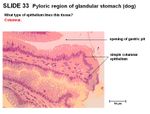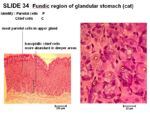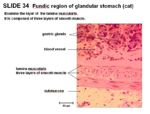Difference between revisions of "Monogastric Stomach - Anatomy & Physiology"
| Line 65: | Line 65: | ||
-More abundant in upper region of glands | -More abundant in upper region of glands | ||
| + | [[Image:Lamina muscularis 3 regions.jpg|thumb|right|150px|Lamina Muscualris 3 Regions - Copywright RVC 2008]] | ||
*3 layers of lamina muscularis: the outer longitudinal, middle circular layers and inner oblique. | *3 layers of lamina muscularis: the outer longitudinal, middle circular layers and inner oblique. | ||
| Line 73: | Line 74: | ||
*Pyloric sphincter is thickened tunica muscularis from the middle circular smooth muscle layer | *Pyloric sphincter is thickened tunica muscularis from the middle circular smooth muscle layer | ||
| − | * | + | *In fundic region, tunica muscularis is thinner, glands are straight and gastric pits are shallow. Abundance of parietal and cheif cells in gland. |
| + | |||
| + | *In pyloric region, tunica muscularis is thicker, glands are coiled and gastric pits are deep. | ||
Revision as of 13:02, 4 July 2008
Introduction
The enlarged swelling of the gastrointestinal tract between the oesophagus and duodenum is called the stomach. It is a simple structure in carnivores and a compound structure in ruminants.
The stomach functions as a reservoir of food where digestion occurs through chemical and mechanical processes. This allows food to be broken down further and absorbed.
Development
- The gut tube is formed from the folding of splanchnopleure (mesoderm and endoderm)
- The mesoderm forms the skeletal muscle (oesophagus and anus), smooth muscle (lateral plate mesoderm) and connective tissue layers around the inner endoderm.
- The endoderm is the inner layer forming the epithelia and glands.
1. Region enlarges. Swelling indicates where the stomach will form.
2. Dorsal surface becomes convex to form the greater curvature
3. Ventral surface becomes concave to form the lesser curvature
4. 2 rotations of 90 degrees occur along the longitudinal axis and then then the dorso-ventral axis
5. The dorsal mesogastrium becomes elongated (with the spleen) and expands into a large fold along the ventral abdominal wall. This becomes the greater omentum which covers all the abdominal organs. It is a superficial structure which is free to move.
6. The ventral mesogastrium becomes the lesser omentum. It is inbetween the stomach and the liver. The rest of the ventral mesentry degenerates.
Functional Anatomy
- Stomach split into regions: cardia, fundic, body and pyloric parts
- Entire stomach motile
- pH 0.9 to 1.5
Histology
- Columnar epithelium
- Folded mucosa
- Invaginations called gastric pits which are continuous with gastric glands
- Chief (zygomatic) cells secreting pepsinogen
-Secreted in response to vagus and gastrin
-Basophilic
-More abundant in base of glands
- Goblet cells secreting mucous
-Protects against autodigestion
- Parietal (oxyntic) cells secreting hydrochloric acid in gastric pits
-Aids digestion
-Activates gastric enzymes, e.g. pepsinogen
-Kills microorganisms that enter with food
-Secreted in response to vagus or pepsin
-Large, pyramis shaped
-More abundant in upper region of glands
- 3 layers of lamina muscularis: the outer longitudinal, middle circular layers and inner oblique.
- Glands are short, coiled, branched tubular. Need to be replaced due to wear and tear. Only in mucosal layer.
- Cardia is a narrow muscle strip
- Pyloric sphincter is thickened tunica muscularis from the middle circular smooth muscle layer
- In fundic region, tunica muscularis is thinner, glands are straight and gastric pits are shallow. Abundance of parietal and cheif cells in gland.
- In pyloric region, tunica muscularis is thicker, glands are coiled and gastric pits are deep.
Blood Supply
- Coeliac artery (which is a branch of the dorsal aorta)
- Coeliac artery splits into the hepatic artery supplying the liver, pancreas and stomach (right gastric and left gastro-epiploic arteries)
- Coeliac artery also splits into the splenic artery which supplies the spleen and the stomach (left gastro-epiploic artery)
- Coeliac artery also splits into the left gastric artery supplying the stomach
- The gastro-epiploic arteries supply the greater curvature of the stomach
- The gastric arteries supply the lesser curvature of the stomach
Digestive Enzymes
- Proteases
-Inactive zymogen -Activated by hydrochloric acid -Active pepsin produced -Completed near brush border to generate small peptides and individual amino acids
- Carbohydrases
-e.g. amylase -Salivary and pancreatic to produce disaccharides -disaccharides converted to monosaccharides near brush border -Celluloses from symbiotic micro-organisms (ruminant stomachs)
- Lipases
-Assisted by bile salts which neutralise stomach acids and emulsifies fats -Generates free fatty acids, monoglycerides and diglycerides
Innervation
- Control of gastric secretions under hormonal (gastrin), paracrine (histamine) and neural (ACh) mediators in the cephalic and gastric phases
- Gastric secretions inhibited during the intestinal phase by CCK and secretin
Species Differences
- Horses have a region called the margo plicatus which separates the glandular and non-gloandular parts of the equine stomach
- The equine stomach is relatively small with a strong cardiac sphincter which prevents the animal from vomiting
- The size of the non-glandular region in the simple stomach varies between species. It is largest in the horse, pig and then smallest in the dog.
- The canid stomach is of variable size. A full stomach can touch the bladder.
- The cardia in the pig is thickened, taking up nearly half the area of the stomach
- Carnivores have a subglandular layer of fibroblasts and collagen fibres for protection, e.g. from consuming bones. It is between the glands and the lamina muscularis.



